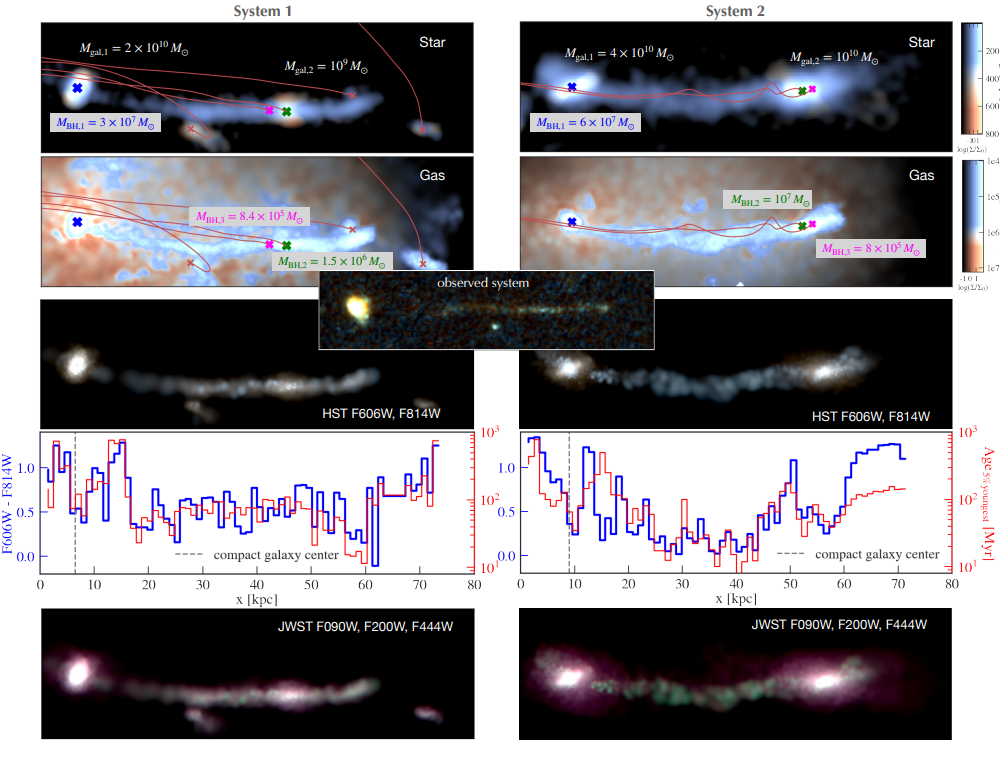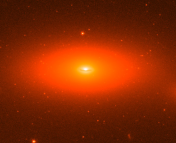Title: Fly-by galaxy encounters with multiple black holes produce star-forming linear wakes
Authors: Nianyi Chen, Patrick LaChance, Yueying Ni, Tiziana Di Matteo, Rupert Croft, Priyamvada Natarajan, Simeon Bird
First Author’s Institution: Carnegie Mellon University, Pittsburgh, USA
Status: Preprint available on arXiv
Earlier this year, a team of astronomers discovered a strange narrow twinkling trail of stars using the Hubble Space Telescope (HST). This “linear feature” originates from the galaxy RCP 28 (figure 1), stretching 62 kiloparsecs in length, and its origin is shrouded in mystery. Initially, this trail was thought to be caused by a “rogue” supermassive black hole that was ejected from its host galaxy. The rogue black hole produces shock waves and lights up the gas, leaving a long starry trail in its wake. The authors of today’s paper however suggest an alternative scenario for the formation of this star-forming linear wake, backed by cosmological simulation studies.

Supermassive black holes (SMBHs), with masses millions to billions times that of our sun are found in the center of most galaxies, even our own Milky Way. When galaxies merge, they give rise to a binary SMBH system at the center of the resulting merged galaxy. Now, picture a third galaxy, with its own SMBH, interacting with this binary system. In this scenario, through complex triple dynamics, the least massive black hole is likely to be ejected, leading to the formation of a runaway black hole. If the observed linear trail of stars indeed stems from a runaway black hole, the implications are exciting! It opens up a new channel to look for massive black holes that have undergone complex interactions with multiple other black holes.
However, it is still not clear if a supermassive black hole (with a mass around solar mass) can produce such a high level of star formation in its wake. This requires theoretical studies and the first step would be to investigate linear wake features in cosmological simulations and trace their origins. This is precisely the approach that the authors undertake in today’s paper.
Looking for linear wakes in cosmological simulations
The authors utilize ASTRID, a cosmological simulation with a large galaxy population, to explore potential connections between linear stellar wakes and runaway black holes. The updated black hole dynamics of ASTRID yield a large number of wandering black holes, some of which may arise due to interactions involving multiple massive black holes.
The authors initiate searches to find galaxies that match the properties of the one observed in the linear wake feature. The feature was observed at a cosmological redshift of z = 0.964 and the galaxies in the search are at a redshift of z=1.3 (the current lowest simulation in ASTRID) and z=2. Additionally, the authors seek out 3-BH systems in these galaxy searches, as a three-body interaction is necessary for the production of a runaway BH. They find around 200 potential runaway BHs in the target galaxies at a redshift of z=2.
To search for linear wakes, the authors look for linear star-forming features around the target galaxies. They visually inspect to find the features with the largest signal-to-noise ratio, finding around 30 linear feature candidates at each of the redshifts.
Now the big question is, do they find any star-forming wakes that match up with the passage of a runaway black hole? The authors surprisingly find no discernible association between runaway black holes and linear stellar features! So, if not runaway black holes, then what mechanism is responsible for generating these linear wakes?

Could a fly-by galaxy encounter be the answer?
Not all of these tuples are observable as multiple AGNs as only few of them would have active gas accretion. The authors find that most of the star-forming wakes originate from a fly-by encounter of a massive galaxy with a newly-merged young galaxy hosting a black hole binary. To illustrate this, they present two representative cases of such systems observed in the simulation (see Figure 2). In the first two rows, we can see the galaxy that does a fly-by encounter with a younger galaxy containing two black holes (all black holes are marked by a cross). They also produce mock images of the systems as would be seen by the Hubble Space Telescope (HST, third row) and the James Webb Space Telescope (JWST, fifth row). The ages of the stars along the wake are plotted in row 4 and it shows that half of the stars are relatively old (around 1 billion years) and the other half are younger (with age less than 100 million years). The HST filters effectively capture the younger stars within the linear wake, while JWST can detect older stars through longer wavelength bands.
In addition, the authors also trace the time evolution of the linear wake in system 1 over a span of a billion years, both prior to and following the prominence of the linear feature. Figure 3 shows this time evolution sequence of the two galaxies (seen face-on) involved in producing the linear stellar feature, with their central black holes highlighted by cross markers. During their fly-by encounter at a velocity of 580 km/s, Galaxy 1 remains undisturbed, while Galaxy 2 undergoes tidal disruption, leading to the development of elongated arms on both sides (see panel 2 and 3 in figure 3). The linear features last for a considerable duration, around 200 million years, after which the two galaxies eventually undergo a head-on collision. Notably, the authors observe that the majority of linear features involve a galaxy with dual black holes along the trailing end. If these dual black holes are actively accreting matter, follow-up observations might detect X-ray emission originating from them.

While the simulations indicate the stellar wake is primarily from fly-by galaxy encounters, the authors acknowledge that the simulation’s resolution limit could allow for the possibility of a runaway black hole being responsible for the origin. The resolution of ASTRID is unable to fully resolve an ejection of a black hole due to three-body interactions. Therefore, the potential origin of linear wakes through runaway black holes cannot be entirely ruled out. To definitively distinguish between these two scenarios, future studies employing simulations with higher resolutions are needed.
Future observations with JWST hold promise in shedding further light on the origins of the star-forming wake. Using JWST’s long-wavelength bands we can examine older stellar populations along the linear feature. Should such older stellar populations be identified along the feature, they would provide support for the galaxy fly-by encounter formation channel. Conversely, the lack of older stars would lead credence to the runaway black hole formation channel for the linear stellar wake.
Astrobite edited by Lili Alderson
Featured image credit: Pranav Satheesh




